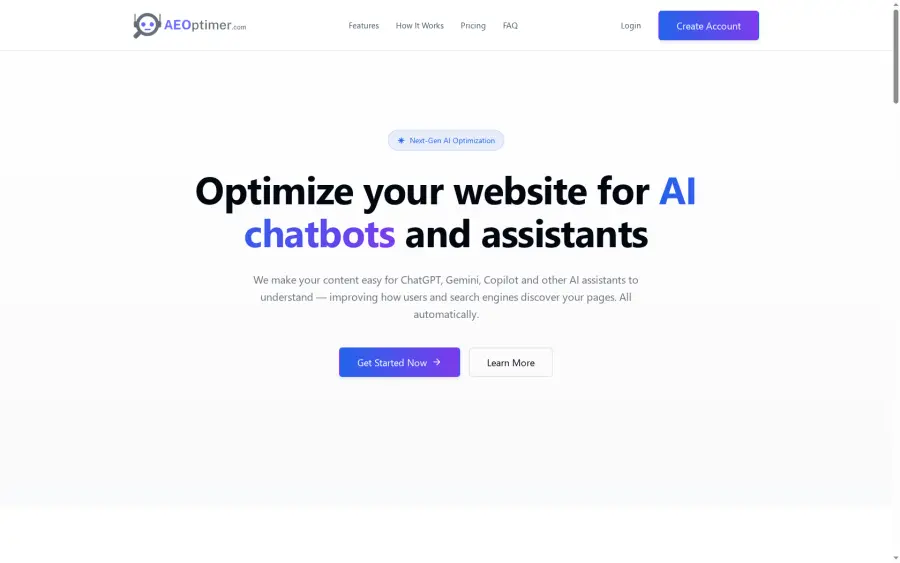How to Update Website Content for AI Visibility Success

Did you know that nearly 70 percent of website content fails to meet the standards required for AI-driven search? As search engines and digital assistants evolve, web content needs to be easy for both humans and machines to understand. Creating content that works for AI means better visibility, higher rankings, and a stronger connection with your audience. By updating your website for AI readiness, you put your brand at the forefront of future web search.
Table of Contents
- Step 1: Audit Existing Site Content For AI Readiness
- Step 2: Set Up Automated Content Optimization Tools
- Step 3: Implement And Configure Update Scripts
- Step 4: Review And Approve Enhanced Content Changes
- Step 5: Verify Content Improvements And Monitor Results
Quick Summary
| Key Point | Explanation |
|---|---|
| 1. Audit content for AI readiness | Systematically review each page’s clarity, structure, and quality to enhance AI discoverability. |
| 2. Utilize automated optimization tools | Integrate tools that continually monitor, detect issues, and provide actionable insights for content improvements. |
| 3. Implement update scripts effectively | Create scripts that automate content updates while maintaining core messaging and structure. |
| 4. Review automated changes thoroughly | Establish a review process to ensure automated modifications align with brand voice and objectives. |
| 5. Monitor and verify content performance | Systematically track AI interactions with your content for ongoing improvements and relevance. |
Step 1: Audit existing site content for AI readiness
Auditing your website content for AI readiness is like giving your digital presence a strategic health check. You will systematically review every page to determine its effectiveness for modern AI search and understanding.
Start by creating a comprehensive inventory of all website pages. Use spreadsheet software or a content management tool to list each URL, page title, and current content type. According to research from Brown University, a content audit involves reviewing each page to assess its quality and relevance.
Next, evaluate each page through an AI discoverability lens. Ask yourself: Would an AI assistant understand the core message? Check for clear headings, structured information, and concise explanations. Look for pages with thin or duplicate content that might confuse AI algorithms.
Here’s a summary of key content audit evaluation criteria:
| Criteria | Description | Importance |
|---|---|---|
| Clarity | Easy-to-understand messaging | High |
| Structure | Use of headings & sections | High |
| Content Quality | Original, relevant, in-depth | High |
| Discoverability | AI can identify main topic | High |
| Redundancy | No duplicate or overlapping content | Medium |
| Conciseness | No unnecessary information | Medium |
| Technical Accuracy | Correct titles, tags, meta info | Medium |
Prioritize pages based on their potential impact. High traffic pages and critical service descriptions should receive immediate attention. Remove or consolidate redundant content that dilutes your site’s clarity. As Yale’s content strategy research suggests, combine a quantitative inventory with a qualitative review of content quality.
Pro Tip: Use AI content analysis tools to get an objective assessment of your pages readiness for machine comprehension.
Once complete, you will have a roadmap for strategic content refinement that makes your website more intelligible to AI search systems and digital assistants. The next step involves implementing targeted improvements based on your audit findings.
Step 2: Set up automated content optimization tools
Automating your content optimization process transforms how you manage website performance and AI discoverability. You will integrate powerful tools that continuously monitor and enhance your digital content without constant manual intervention.
Research from the University of California Davis highlights the importance of implementing automated scanning tools like Siteimprove. These platforms can automatically detect accessibility issues, SEO problems, broken links, and spelling errors that might impact your site’s performance and AI readiness.
Start by researching tools specifically designed for content optimization. Look for platforms that offer comprehensive scanning capabilities including metadata analysis, content structure review, and AI compatibility checks. According to Harvard’s digital resources, utilizing built-in tools like metatags and meta descriptions supports both SEO and AI engine optimization efforts.
Connect the selected tool directly to your website through integration scripts or plugins. Configure scanning frequency most appropriate for your content update cycles. Some tools offer weekly or monthly comprehensive content audits that can automatically flag potential improvements or inconsistencies.
Pro Tip: Choose tools that provide actionable insights and prioritize recommendations based on potential impact.
Ensure the optimization tool can generate detailed reports showing content health scores, recommended changes, and potential AI discoverability barriers. These insights will guide your ongoing content refinement strategy.
 The next step involves implementing the recommended optimizations systematically across your website.
The next step involves implementing the recommended optimizations systematically across your website.
Step 3: Implement and configure update scripts
Configuring update scripts transforms your website into a dynamic system that automatically adapts to AI search requirements. You will create intelligent mechanisms that continuously optimize your content without manual intervention.
According to research from the University of California Davis, developing a content lifecycle involves creating strategic plans for regular content reviews and updates. Begin by selecting a scripting language compatible with your website platform such as JavaScript or Python. These scripts will handle automated content scanning and potential modifications.
Design scripts that perform specific optimization tasks. Research from Harvard highlights the importance of addressing crawling and indexing issues. Your scripts should focus on key areas like checking HTML tags, verifying keyword relevance, updating metadata, and ensuring proper sitemap configuration.
Establish clear parameters for what your update scripts can modify. This might include automatically refreshing stale content, standardizing heading structures, or flagging sections that require human review. Create safeguards to prevent unintended changes that could disrupt your website’s core messaging or design.
Pro Tip: Always implement a staging environment to test update scripts before deploying them to your live website.
Schedule your scripts to run during low traffic periods to minimize potential disruptions.
Most websites benefit from weekly or monthly automated content refresh cycles. The next step involves monitoring script performance and fine tuning your optimization strategy based on initial results.
Step 4: Review and approve enhanced content changes
Reviewing and approving content changes is your final quality control checkpoint in the AI optimization process. You will carefully examine automated modifications to ensure they align with your brand voice and communication objectives.
According to research from Brown University, conducting a thorough content audit involves evaluating revised content for accuracy, relevance, and quality before publication. Start by creating a systematic review workflow that allows you to methodically check each proposed change.
Divide your review into distinct stages. First, assess the technical accuracy of modifications. Check that updated metadata, keywords, and structural changes support AI discoverability without compromising readability. Research from Yale University emphasizes the importance of a qualitative content audit that reviews site content holistically and in detail.
Next, read through the proposed changes with a critical eye. Verify that automated scripts have not inadvertently altered the core message or removed nuanced language that gives your content personality. Look for opportunities to refine machine generated suggestions while maintaining your unique communication style.
Pro Tip: Create a checklist of non negotiable content requirements to quickly validate automated changes.
Establish a clear approval process where significant modifications require human sign off. Some changes can be automatically approved, while others might need manual review. The final step involves implementing approved changes and preparing for continuous optimization cycles.
Step 5: Verify content improvements and monitor results
Verifying content improvements transforms your website optimization from a passive to an active strategy. You will systematically assess how AI tools interpret and interact with your updated content to ensure maximum discoverability and relevance.
According to research from the University of California Davis, engaging directly with AI tools can provide critical insights. Start by searching for your content using various AI platforms and asking these tools to summarize your web pages. This practical approach helps you understand how machines comprehend and represent your information.
Implement a comprehensive monitoring framework that tracks key performance indicators. Look beyond traditional metrics like page views and examine how frequently your content appears in AI generated search results or summaries. Research from Harvard emphasizes the importance of keeping content fresh and accurate by regularly updating key pages and removing outdated information.
Create a feedback loop where you continuously compare AI generated summaries against your original content. Pay attention to nuances in how AI interprets your messaging. Are the key points being accurately captured? Do the summaries reflect your intended communication strategy? Use these insights to make incremental refinements.
Pro Tip: Use multiple AI platforms to get a more comprehensive view of how your content is being interpreted.
Schedule regular review cycles to assess your content optimization strategy. The goal is not just static improvement but ongoing adaptation to evolving AI search and comprehension technologies. Your next steps involve using these insights to continually refine your approach.
Take Control of Your Website’s AI Visibility Today
The challenge of aligning your website content with evolving AI search requirements can feel overwhelming. From auditing your content to configuring update scripts, the process demands precision and ongoing attention. Many website owners struggle with keeping up with AI discoverability factors like structured data, metadata accuracy, and content freshness without sacrificing their site’s identity.
Imagine a solution that handles these complex tasks for you automatically while preserving your unique voice and design. Aeoptimer is designed specifically to solve these pain points by continuously optimizing your website’s content for AI assistants and search engines. Our platform automates key steps like sitemap detection, content analysis, and monthly updates so you can focus on growing your business instead of manual maintenance.

Don’t let your website fall behind in AI-driven search results. Experience how effortless AI visibility success can be with aeoptimer.com. Get started now and empower your site with smart, automated optimization that evolves as AI technologies do. Take the first step toward seamless content enhancement by exploring how automatic AI-friendly updates can revolutionize your digital presence.
Frequently Asked Questions
How do I audit my existing website content for AI readiness?
Start by creating a detailed inventory of all website pages, listing each URL and its content type. Evaluate clarity, structure, and quality to determine if the messaging is easily understandable by AI.
What tools can help automate my content optimization process for AI visibility?
Use automated content optimization tools that scan for accessibility issues, SEO problems, and metadata accuracy. Choose a tool that provides actionable insights, and set it to run weekly or monthly for regular performance checks.
What types of update scripts should I implement for enhancing my website content?
Implement scripts that focus on checking HTML tags, verifying keyword relevance, and updating metadata. Schedule these scripts to run during low traffic periods to minimize disruptions and ensure regular content refresh cycles.
How can I ensure the changes made to my content align with my brand voice?
Create a systematic review workflow to assess all proposed changes, verifying that they maintain your core messaging. Use a checklist of non-negotiable content requirements to quickly validate automated modifications and ensure quality control.
How do I monitor the effectiveness of my content updates for AI visibility?
Verify improvements by directly engaging with AI tools and asking them to summarize your content. Track key performance indicators, such as how often your pages appear in AI search results, and adjust your strategy based on these insights to keep content fresh and relevant.
What should I focus on when reviewing AI-generated summaries of my content?
Pay attention to whether the AI captures key points accurately and reflects your intended messaging. Use this feedback to refine and improve your content continuously, ensuring it aligns with both AI capabilities and your communication goals.





